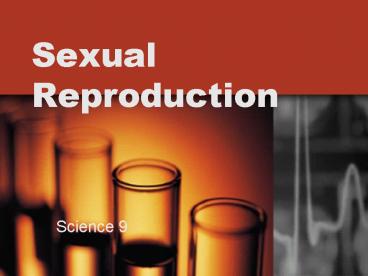Understanding Sexual Reproduction - PowerPoint PPT Presentation
1 / 22
Title:
Understanding Sexual Reproduction
Description:
The process that ensures each gamete contains only one-half set of chromosomes ... In meiosis each gamete has a different combination of the chromosomes that were ... – PowerPoint PPT presentation
Number of Views:533
Avg rating:5.0/5.0
Title: Understanding Sexual Reproduction
1
Understanding Sexual Reproduction
- Science 9
2
Sexual Reproduction
- The word "homologous" comes from the Greek word
"homologos," - It means agreeing.
- How do the chromosomes in a homologous pair
"agree" with each other?
3
Mitosis and Asexual Reproduction
- When a body cell, such as a skin cell, undergoes
mitosis and cell division, two new identical skin
cells are produced. - One parent divides mitotically to produce two
identical offspring. - Another process is responsible for producing
unique or non-identical individuals.
4
- This process is called
- Sexual Reproduction
5
Sexual Reproduction
- Your body has specialized organs that make
specialized cells, or gametes, for sexual
reproduction. - These gametes from two parents combine during a
process called fertilization to form a new cell,
or zygote. - This zygote is the first body cell of a new
organism.
6
Sexual Reproduction
- Where do gametes come fro?
- How are they different from body cells?
- Why are gametes necessary for sexual reproduction?
7
Sexual Reproduction
- Your 46 chromosomes could be arranged into 23
pairs of chromosomes that resemble each other in
size and shape. - Matching" pairs of chromosomes are known as
homologous pairs. - You receive one member of each pair from your
mother, the other from your father.
8
Sexual Reproduction
- Chromosomes in a human body 46
- Human Body cells are called diploid.
- di double
- The human diploid number is ___
- (hint 2 X number of pairs)
- Human gametes are called haploid because they
have half the number of cells that normal cells
have. - ha half
9
Sexual Reproduction
- Number of Chromosomes16
- Number of homologous pairs ?
- Diploid Number ?
- Haploid Number ?
10
Sexual Reproduction
- The body cells of every typical organism in a
species have the same number of chromosomes in
each cell. - This is the diploid number
- This number stays the same from one generation to
the next. - The gametes of the same species have the haploid
number.
11
Sexual Reproduction
- In order for the human chromosome number to
remain at 46, gametes must have one-half the
number of chromosomes of normal body cells. - Only haploid gametes can combine during
fertilization to form a diploid zygote. - Only a diploid zygote can function as the
offspring's first body cell
12
Meiosis
- Mitosis ensures that chromosome number does not
change. - The process that ensures each gamete contains
only one-half set of chromosomes is called
meiosis. - In meiosis each gamete has a different
combination of the chromosomes that were present
before meiosis. - Offspring have the potential to be different from
parents.
13
Meiosis I
14
Meiosis II
15
(No Transcript)
16
Meiosis
- Why are some of the chromosomes in the new nuclei
not identical to the originals? - During the early part of meiosis, double-stranded
chromosomes come together. - Crossing over occurs
17
Meiosis
- Sexually reproducing animals produce gametes in
reproductive organs called gonads. - Male gonads are called testes and female gonads
are called ovaries.
18
Meiosis
- Sexually reproducing animals produce gametes in
reproductive organs called gonads. - Male gonads are called testes and female gonads
are called ovaries.
19
Meiosis
- During the process of fertilization, gametes come
together to produce a zygote, - Zygote then starts to divide through mitosis to
develop all the cells of a new organism.
20
Meiosis
- Meiosis occurs continuously in the testes of
human males once their gonads are sexually
mature. - In females, meiosis begins in the ovaries before
birth, then stops until the age of about 12 to 15.
21
Meiosis
22
(No Transcript)































